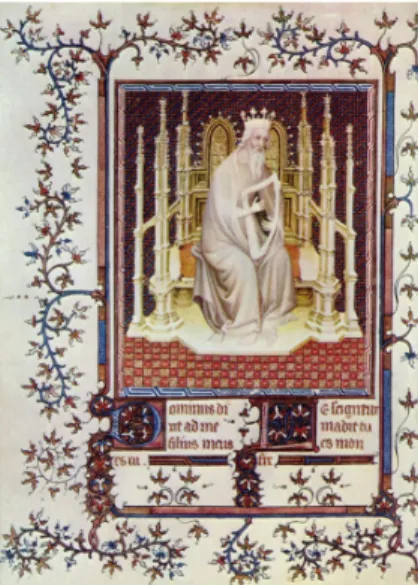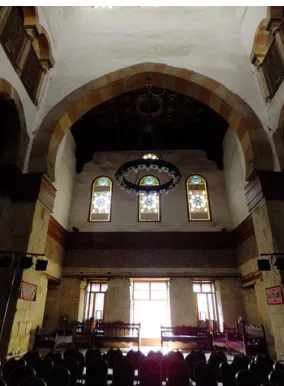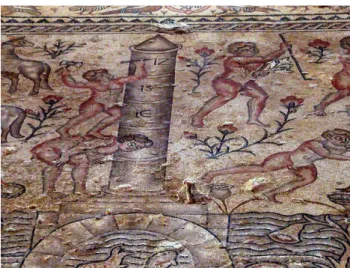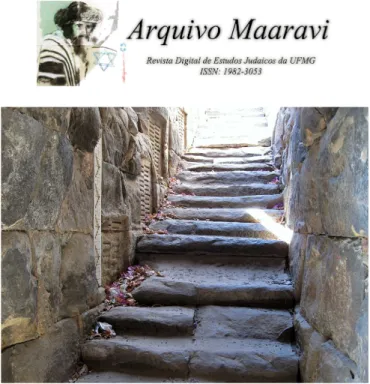Medieval Rulers as Reflection of the Biblical Kings in Abraham Ibn Ezra's Commentaries on the Bible
Governantes medievais como reflexão dos reis bíblicos nos comentários de Abraham Ibn Ezra sobre a Bíblia
Abraham Ofir Shemesh* Ariel University | Ariel, Israel avi0603@013.net.il
Abstract: This article deals with the influence of the Islamic culture in medieval times
on the Biblical commentaries of Rabbi Abraham Ibn Ezra. According to Ibn Ezra the reality in the Muslim region, which includes the Bible lands preserves the ancient ways of life. The current study focuses his comparison between Arabs rulers and ancient kings' customs.
Keywords: Bible. Muslims Kings. Abraham Ibn Ezra.
Resumo: Este artigo aborda a influência da cultura islâmica na época medieval sobre
os comentários bíblicos do rabino Abraham Ibn Ezra. De acordo com Ibn Ezra, a realidade na região muçulmana, que inclui as terras da Bíblia, preserva os antigos modos de vida. Este estudo concentra sua comparação entre os governantes árabes e os costumes dos reis antigos.
Palavras-chave: Bíblia. Reis muçulmanos. Abraham Ibn Ezra.
Rabbi Abraham Ibn Ezra (c. 1090-1164) was born in Toledo, in Muslim Spain. He operated in Spain for the first five decades of his life, and during this period, he travelled to different countries in North Africa, such as Tunisia, Morocco, and Algeria. Following the occupation of Al-Andalus (Muslim Spain or Islamic Iberia) by the Murābiṭūn (نﻮﻄﺑاﺮﻣ) tribes in 1090, and then the Al-Mohads (al-Muwaḥḥidūn نوﺪﺣﻮﻤﻟا) in 1145, many Jews and Christians, among them Ibn Ezra, were compelled to migrate to Christian countries. For the next three decades he travelled to Christian countries in western Europe – Italy, France, and England – where he utilized the knowledge he had amassed in his youth and adulthood to interpret biblical literature.1
* Senior Lecturer in Facultaty of Social Sciences and Humanities, Ariel University. 1 On Ibn Ezra's date of birth and biography, see VEIZER, 1976, p. 7-51; LEVINE, 1970,
Ibn Ezra, an intellectual and fertile man of science, engaged in varied fields: biblical commentary, linguistics, philosophy, liturgical poems, mathematics, astronomy and astrology.2 His unique intellectual abilities undoubtedly resulted from his personal
skills, but they were also enhanced by his life events and his travels to different geographical regions, places, and cultures that enriched his knowledge.
The goal of the current paper is to present the exegetical principle of R. Abraham Ibn Ezra that some royal practices were shared by rulers of ancient Egypt (Pharaoh) and by medieval Muslim and Christian European rulers. In this paper, I shall focus his commentary to Exodus 7:15 that Pharaoh ventured out to check the level of the water, as customary of Muslim sultans in his own time.
1 The Muslims culture and the biblical reality
In his biblical commentary, R. Abraham Ibn Ezra occasionally voices the contention that the language, culture, and life style of the Muslim world is capable of contributing to our understanding of contemporary aspects of biblical stories and laws. The material customs and culture of medieval Arabs reflect biblical reality, as the countries of the bible, including the Land of Israel and Egypt, are part of the Arab world. In contrast, Christian countries constitute a different cultural sector, and hence it is not possible to use them to draw conclusions about life in biblical times. He speaks of the irrelevance of European countries for understanding biblical customs in his lengthy commentary on Exodus 12:7 and on Exodus 28:36, written in 1153 in the city of Daros or Rodus, probably the city Rouem in Normandy, northern France.3
2 The Medieval Arabs Rulers and the Kings of Bible
In his commentary on various biblical verses, Ibn Ezra interprets the customs of the kings in biblical times based on those in his own period, although it is not clear from where he derives his knowledge in this area. Ibn Ezra did not have any high position in the royal palaces, not as a vizier nor as a Court Physician, such as R. Moshe ben Maimon (Maimonides, Rambam, 1138-1204), who served as a court physician and personal physician of Saladin's son, the Egyptian Ayoubi ruler El Fadil (ﻞﺿﺎﻔﻟا).
There are many examples for Ibn Ezra's comparison between the biblical kings and the rulers in his own period:
2 ZARFATI, 1968, p. 130-155; LANGERMANN, 1993, p. 28-85; GOLDSSTEIN, 1996, p.
9-21; SELA, 1999, p. 72-85; SELA and FREUDENTHAL, 2006, p. 13-55.
1 Laying "clothes" on the chairs of kings: The prophet Isaiah describes God sitting
on a high throne: "לָכיֵהַה תֶא םיִאֵלְמ ויָלוּשְׁו אָשִּׂנְו ם ָר אֵסִּכּ לַע בֵשֹׁי יָנֹדֲא תֶא הֶא ְרֶאָו" (Isaiah 6:1)4. Ibn
Ezra elucidates the word "ויָלוּשׁ" as the margins of the royal chair, that is the "clothes" (=linen) of the chair. He reports the custom to lay these clothes on the king's thrones, probably for comfortable (Figures 1-2).
Figure 1: Alfonso X of Castile (1221–1284) sitting on a throne with wide linen. From: The Libro de los Juegos, ("Book of Games").
Figure 2: King David sitting on a throne with short orange linen (illustration). From: The Psalter of Jean de
Berry, André Beauneveu (1335-1400).
2 Building glass windows in royal palaces: Isaiah consoles Jerusalem and promises
to build the city with wonderful and prestigious materials: ךְִי ַרָעְשׁוּ ךְִיַתֹשְׁמִשׁ דֹכְדַכּ יִתְּמַשְׂו" "ץֶפֵח יֵנְבאְַל ךְֵלוּבְגּ לָכְו חָדְּקֶא יֵנְבאְַל (Isaiah 54:12). Ibn Ezra explains the word "ךְִיַתֹשְׁמִשׁ" as
4 The Revised Standard Version (RSV) translates: "In the year that King Uzzi'ah died I
saw the Lord sitting upon a throne, high and lifted up; and his train filled the temple".
windows. He claims that royal palaces have glass windows, but God will build Jerusalem with precious stones.5 Glass in medieval Islam was widely produced from
Egypt to central Asia. Glass had a significant role in the Islamic world, both as an artistic medium and as economically viable material widely used to make windows and container for commercial goods.6 According to Elkandi, an early use of glass
windows was reported in the Aḥmad ibn Ṭūlūn (نﻮﻟﻮط ﻦﺑ ﺪﻤﺣأ ) mosque (AD 868), and in houses such as the palace of Bashtak (كﺎﺘﺸﺑ ﺮﯿﻣﻷا ﺮﺼﻗ) in Cairo in 1334.7 However,
Ibn Ezra reports on the use of glass windows in royal courts earlier (Figure 3).
Figure 3: View of the qa'a (reception hall) of the Bashtak palace. From: Casual Builder, GNU Free Documentation License.
3 The royal habit of getting angry at one's servants - The prophet Amos admonishes
Israel because of their sins, and promise to punish them, in spite of the fact that they were chosen to be his people: לָכּ תֵא םֶכיֵלֲע דֹקְפֶא ןֵכּ לַע הָמָדֲאָה תוֹחְפְּשִׁמ לֹכִּמ יִתְּעַדָי םֶכְתֶא ק ַר" "םֶכיֵתֹנֹ וֲע (Amos 3:2).8 Ibn Ezra notes that the same form of reaction is common by
human kings when they become angry with their servants.
5 "I will make your pinnacles of agate, your gates of carbuncles, and all your wall of
precious stones" (RSV).
6 MERI; BACHRACH, 2006, p. 298-297; ELKADI, 2016, p. 5. 7 ELKADI, 2016, p. 6.
8 "You only have I known of all the families of the earth; therefore I will punish you
4 The royal crown: In Psalms 21:4, the poet expresses the goodness and kindness of
God towards the Hebrew king, that he sets a crown upon his head: " ת ֶרֶטֲע וֹשׁאֹרְל תיִשָׁתּ" זָפּ (Psalms 21:4).9 Ibn Ezra describes the ateret as a royal crown embedded with gold
and gems (paz), which is common in his period.
5 Demonstrating queen's beauty before the ministers - The demand of the Persian
king Ahasuerus to display the queen's beauty before the ministers in Esther 1:11 (הָּיְפָי תֶא םי ִרָשַּׂהְו םיִמַּעָה תוֹא ְרַהְל), Ibn Ezra states that this is customary among the kings of Edom, i.e., in Christian Europe (Esther 1:11).
6 The King of Medieval Egypt and Pharaoh: Before the plague of blood, God
instructs Moses to meet with Pharaoh by the Nile early in the morning: "Go to Pharaoh in the morning, as he is going out to the water; wait for him by the river's brink" (Exodus 7:15). Ibn Ezra suggests two interpretations of Pharaoh's visit to the Nile. In his lengthy commentary on Exodus 8:16 he claims that kings venture out to the river in the morning to look at the water for medical reasons: "A custom of the kings is to go to the river in the morning, because looking at the water is good for the eyes".10 He does not state which kings he means, but according to his general outlook
whereby the Arab world is a good indication of the conduct of rulers in biblical countries, he probably meant Muslim kings.
Muslim medieval palaces were located outside the cities, in green areas with an abundance of water. The location of the palaces on the outskirts of the cities was a consequence not only of seeking "fun and pleasure", such as to provide water for the palace gardens or extensive hunting estates, rather first and foremost for economic and political reasons. In a separate city the ruler could isolate himself from public opinion and keep his soldiers away from contact with the city. Moreover, the royal villas provided significant revenue for the state and patrons, supplied the court with the luxury crops.11
According to Ibn Ezra even looking at the water is good for one's health. This stems from a common medical view in the Middle Ages, whereby looking at the light reflecting from the water or from mirrors "illuminates" the eyes. For example, R. Meir ibn Aldabi of Spain (1310-1360) recommends the following to one who suffers from faulty vision: "And one who does not see well […] should place his face above hot water to receive the smoke [=steam] and should look at clear water."12
9 "thou dost set a crown of fine gold upon his head" (RSV). 10 IBN EZRA, 1976, Exodus, Long Commentary, p. 57.
11 RUGGLES, 2000, p. 53-85; ANDERSON, 2008, p. 53-79; PELNER COSMAN;
JONES, 2008, p. 150.
In his long commentary on Exodus 7:15, Ibn Ezra applies the principle of understanding ancient times through contemporary reality in a different way. He suggests that Pharaoh went to the Nile to check the level of the water, as he thought was customary among Egyptian Muslim rulers of his time:
It is the custom of the King of Egypt to this day to go out in the months of Tamuz and Av because that is when the Nile rises, to see how much it has risen (VEIZER, 1976, p. 53).
In his short commentary on this site, Ibn Ezra emphasizes that choosing the water level measuring event as a meeting point was intended to publicize the miracle of the Nile's affliction:
It may have been close to the time that the Nile rises, and the king went out to see this. And God commanded that this wonder be performed in front of Pharaoh when he went there (VEIZER, 1976, p. 253).
The choice of this timing probably had two reasons: a. The public nature of the event and the intention to publicize God's might before all those present at the occasion, and not only the king; b. Denigration of the Nile as an idolatrous object that inundates life upon Egypt, particularly at the time when the rising water level was being celebrated. The question is why did the King of Egypt check the water level?
3 Checking the Nile Level
From June to September, the water level in the part of the Nile that lay within Egypt's geographical boundaries would rise as a result of the summer rains in the sources of the Blue Nile and White Nile. The water of the Nile is one of Egypt's most important natural resources. Major industries in the ancient Egyptian economy, such as hunting, fishing, and agriculture, were dependent on the Nile.13The flooding season
(In ancient Egyptian: akhet), resulting from the rise in the water level, was crucial for the artificial irrigation of the fields and also for enriching the fields with nutrient-rich silt thanks to the flat plains that bordered the Nile. When the level of the Nile was low or when it dropped in the low season it was necessary to draw the water up, for example with a shaduf (فودﺎﺷ), a technique that required much effort and labor.14
R. Ibn Ezra base his interpretation on the custom of measuring the water level in the Nile, customary among Muslim rulers in medieval times. Ibn Ezra indeed never visited Egypt, but he appears to have known about this from external sources. Contemporary sources indicate that the level of the water was usually measured by
13See BODENHEIMER, 1957, p. 195.
14 On the traditional Egyptian agriculture and irrigation system in the Middle Ages
priests by means of the Nilometer, a column submerged in the water, on which markings were used to determine the depth (see Figure 4).15
Figure 4: Mosaic showing Nilometer, Tzippori, Israel.
There are many milometers in Egypt:
1 Such a device, dated in the early Middle Ages (9th century) and housed in a stone
structure, remains standing on the island of al-Rhoda (ﺔﺿوﺮﻟا) in central Cairo. The construction of the Nilometer on the island of Rhoda is dated in 861 AD, commissioned by the Abbasid caliph al-Mutawakkil I (ruler of Samarra from 847-861). However it appears to have been built on an earlier device. 16
2 The nilometer of the Temple of Edfu dedicated to the falcon god Horus. It is located on the west bank of the Nile in Edfu in Upper Egypt.
3 Two nilometers are located in Elephantine (ﻦﯿﺘﻨﻔﻟا ةﺮﯾﺰﺟ ) an island on the Nile, both belonging to each their god and temple (see Figure 5).
15 FRIEDMAM, 2001, p. 59-60; FRIEDMAM, 2008, p. 1751-1760. 16 On the nilometer of Rhoda in medieval Egypt see POPPER, 1951.
Figure 5: The notches of the nilometer in Elephantine. Source: Olaf Tausch, GNU. Free Documentation License.
When the water would reach a height of 60-80 cubits, i.e., 9.3-10.4 m., the agricultural crops were bound to be of good quality. Beginning from the Fatimi period, the "Plenitude of the Nile" was celebrated. During the celebrations, the caliph would approach the Nilometer in a decorated ship and would perfume it with saffron.17
Indications of the merriment that accompanied the rising water are described in the commentary of R. Yehoshua ibn Shuaib (Spain, circa 1280-1340) on Exodus 7:15: "And it is already well known and written in the books of the Egyptians that when the Nile would rise the people would gather and have a great festival and they would say: Grow lamb [the Aries zodiac sign], rise Nile, rise Nile".18 Ibn Shuaib
reports that celebrations of the water's abundance are documented in the literature of Egyptian royalty. In this, he alludes to the concept whereby the Egyptians' gratitude for the abundant water was linked to their perception of Aries as affecting the water level.
The act of checking the water level might indicate that Egyptian rulers recognized that the fate of their people and even their own position were dependent on the water sources. A water shortage may have resulted in severe famine, a reduction of taxes on crops, and government instability. In contrast, too much water could lead to destruction of the agricultural canals and to disaster.19
17 MERI; BACHRACH, 2006, p. 273, 561-562. 18 IBN SHUAIB, 1969, Parshat Va'era, 23a.
19 Although the Nile was usually a stable source of water, in certain years its flow was
significantly reduced, causing heavy famine in Egypt. See Genesis 41:54; Ezekiel 30:12; Zechariah 10:11.
In summary, Ibn Ezra in the opinion that the reality in the Muslim region, which includes the Bible lands preserves the ancient kings manners and ways of life. According to this assume, he interprets the meeting of Moses and Pharaoh near the Nile and other verses in the Bible.
References
ANDERSON, Glaire D. Villa (Munya) Architecture in Umayyad Córdoba: Preliminary Considerations. In: ANDERSON, Glaire. D.; ROSSER-OWEN, Marian (Ed.). Revisiting al-Andalus: Perspectives on the Material Culture of Islamic Iberia and Beyond. Leiden; Boston: Brill, 2007. p. 53-79.
BIBLE. The Revised Standard Version (RSV).
BODENHEIMER, Shimon F. Animal Life in Biblical Lands: From the Stone Age to the End
of the Nineteenth Century. v. 1. Jerusalem: Biyalik Institute, 1957 [Hebrew].
BORSCH, Stuart J. Nile Floods and the Irrigation System in Fifteenth-Century Egypt.
Mamluk Studies Review, v. 4, p. 131-145, 2000.
ELKADI, Hisham. Cultures of Glass Architecture. New York: Routledge, Taylor & Francis, 2006.
GOLDSSTEIN, Bernard. R. Astronomy and Astrology in the Works of Abraham ibn Ezra. Arabic Sciences and philosophy, v. 6, p. 9-21, 1996.
IBN ALDABI, Meir. Shevilei Emunah (Paths of Belief). Warsaw: Zisberg Press, 1874. IBN EZRA, Abraham. Ibn Ezra: Commentary on the Torah. Asher Veizer edition. Jerusalem: Mosad Harav Kook, 1976.
IBN SHUAIB, Yehoshua. Homilies on the Pentateuch (facsimile edition Cracow 1573). Shraga Abramson edition. Jerusalem: Makor, 1969.
FRIEDMAN, Zaraza. The Nilometer. Measuring and Weighing in Ancient Times. Haifa: The Reuben and Edith Hecht Museum, University of Haifa, 2001.
FRIEDMAN, Zaraza. Nilometer. In: SELIN, Helaine (Ed.). Encyclopaedia of the History
of Science, Technology, and Medicine in Non-Western Cultures. Berlin; New
York: Springer, 2008.
KISLEV, Itamar. The Relationship between the Pentateuch Commentaries Composed by R. Abraham Ibn Ezra in France and the Significance of this Relationship for the Biographical Chronology of the Commentator. Journal of Jewish Studies, v. 60, p. 282-297, 2009.
LANGERMANN, Y. Tzvi. Some Astrological Themes in the Thought of Abraham ibn Ezra. In: TWERSKY, I.; HARRIS, J. M. (Ed.). Rabbi Abraham ibn Ezra: Studies in the
Writings of a Twelfth-Century Jewish Polymath. Cambridge: Harvard University Press,
LEVINE, Israel. Abraham Ibn Ezra: His Life and His Poetry. Tel Aviv: HaKibbutz HaMehuchad, 1970.
MELAMED, Ezra Zion. Biblical Commentaries: Their Methods and Approaches. Jerusalem: Magnes Press, Hebrew University, 1978 [Hebrew].
MERI Josef W.; BACHARACH, Jere L. Medieval Islamic Civilization. New York: Routledge, Taylor & Francis, 2006. v. 1-2.
PELNER COSMAN, Madeleine; JONES, Linda Gale. Handbook to Life in the Medieval
World. v. 1. New York: Infobase Publishing, 2008.
POPPER, William. The Cairo Nilometer: Studies in Ibn Taghrī Birdī's Chronicles of Egypt. Berkeley; Los Angeles: University of California Press, 1951.
RUGGLES, D. Fairchild. Ruggles, Gardens, Landscape, and Vision in the Palaces of Islamic
Spain. University Park: Penn State University Press, 2000.
SELA, Shlomo. Astrology and Biblical Exegesis in the Thought of Abraham Ibn Ezra. Ramat Gan: Bar-Ilan University, 1999 [Hebrew].
SELA, Shlomo; FREUDENTHAL, Gad. Abraham Ibn Ezra's Scholarly Writings: A Chronological Listing. Aleph, v. 6, p. 13-55, 2006.
SIMON, Uriel. The Ear Discerns Words: Studies in Ibn Ezra's Exegetical Methodology. Ramat Gan: Bar Ilan University Press, 2013 [Hebrew].
ZARFATI, Gad ben Ami. Mathematical terminology in Hebrew medieval scientific
literature. Jerusalem: Magnes Press, Hebrew University, 1968 [Hebrew].
---
Recebido em: 09/08/2017. Aprovado em: 09/09/2017.



